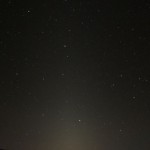A strange glow visible long after sunset, or well before dawn, along the path of the Sun in the sky. Called the “False Dawn” by Muhammad in Islamic texts and by other classical sources, this glow is often confused with the light of dawn, or simply overlooked by many.

The answer is simply dust.
Space is not only very big and mostly empty, it can also be dirty. Dust from comets, dust from asteroid collisions, dust floating in orbit about the Sun, reflecting sunlight and glowing across the sky. Because this dust lies in the plane of the solar system the glow is visible as a band along the ecliptic and through the constellations of the zodiac. The dust is thickest, and the glow brightest nearer the Sun, thus the glowing dust is best seen when the Sun is just out of sight, after dusk, or before dawn. The light is simply reflected light. Looking at the spectrum of the zodiacal light shows it to be sunlight, with the same spectral features.
The zodiacal light can be quite bright, clearly visible to any who look in the hour after dusk, or before dawn. It can be bright enough to be a nuisance to amateur astronomers attempting to view through their telescopes. At the same time it is a sign of clear dark skies, as it is otherwise hidden by the glow of artificial light. The slightest amount of moonlight or light pollution and this glow disappears from sight.
The effect can be seen completely across the sky, along the ecliptic, as a very faint glowing band when viewed from the darkest of places. Directly opposite the Sun in the sky is a brighter spot in the glow, the gegenschein or counterglow. A form of glory, the dust reflects sunlight back in the direction it came.
The zodiacal band and the gegenschein are both visible from Mauna Kea on a dark night. From this dark place the most subtle of astronomical spectacles can be appreciated.

